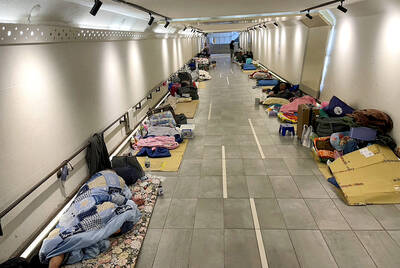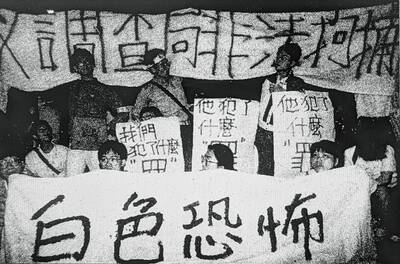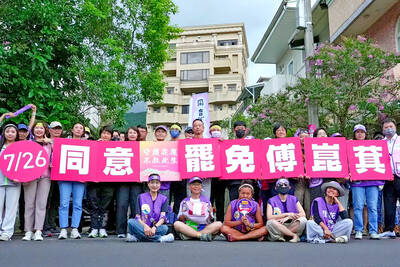Taiwan Designers’ Week gives designers a chance to show off what fires up their creative engines. Now in its fourth year, the event opened on Friday last week and runs until Sunday at Huashan 1914 Creative Park (華山1914).
The theme of this year’s festival is “Care, I Care.”
“It means caring about our lives, our surroundings and the environment,” said Hung Ching-feng (洪慶峰), the deputy minister of the Council for Cultural Affairs (文建會) at a press conference last Friday. “People want to see how design is relevant to their daily lives. That’s our challenge.”
More than 300 designers are represented at the festival. The event, which gives Taiwanese designers a platform for independent projects, has expanded considerably since it was first launched in 2007 at Eslite Bookstore’s Xinyi branch (誠品信義店). A designers’ market with 27 vendors took place last weekend and will return on Saturday and Sunday. In addition to Taiwan, this year’s event includes design brands from Germany, Sweden, Japan, the US and the Netherlands.
The main gallery of Taiwan Designers’ Week is split into 13 themed exhibits, each run by a group of designers.
Sixteen students from Tatung University Culture-Based Design Lab (大同大學文化設計研究室) saw this year’s theme as an opportunity to examine Taiwan’s aesthetic identity. Their exhibit, Facing the Mirror (照鏡子), features objects inspired by this country’s culture and each designer’s personal experiences.
Eric Cheng (鄭宇庭) satirizes the labeling of his peers as the fragile “Strawberry Generation” (草莓族) with a pair of sandals balanced on heels shaped like the fruit. A side table by Tsai Yi-cheng (蔡易成) looks like a Victorian antique, but a closer inspection reveals that the legs are built from stacked beverage bottles, with different brands (including Taiwan Beer and Yakult yogurt) recognizable by their silhouettes.
Tsai says Taiwan’s exposure to different cultural influences gives its designers a wide range of references to draw upon, but makes it harder to define the country’s own aesthetic.
“Scandinavia and Japan are two places that are known for having a very recognizable design style. We want to think of a way to show the world what Taiwanese style is,” says Tsai. “To do that, we have to understand our strong points and what makes us different from other countries.”
A neighboring exhibit, Love Feast (愛宴), features the work of 20 Christian designers.
“We all work for different companies, but we also use our skills to express our faith,” says Joyce Wan (萬宜家). “It’s a way for us to spread the gospel and let people know about God’s love.”
Over the last two months the designers, who attend different churches, gathered on Saturday evenings to prepare Love Feast. Their creations, arranged around a banquet table, use everyday objects to reflect on spirituality.
Salt and pepper shakers by David Kang (康家彰) and Peter Kou (寇志綱) are shaped like boulders with a small human-shaped figure pushing against them.
“When you shoulder obstacles, it is exhausting, but eventually you develop strength and balance. And God is the spice of life,” says Love Feast co-organizer Amy Wu (吳靜宜).
Wu’s own creation is a set of angular red erasers that gradually become softly rounded hearts as they are used. “They symbolize forgiveness and the ease of mind it brings,” she says.
Environmental awareness is a popular theme this year, with three exhibits showcasing items made from eco-friendly or recycled materials.
Less of Everything (一切從減), organized by the National Taiwan Craft Research and Development Council
(國立臺灣工藝研究發展中心), focuses on the design potential of driftwood gathered in Pingtung County. Items including eating utensils, loudspeakers and furniture preserve the natural curves and grain of planks and branches.
“We start by looking at the shape of the wood and thinking of what it can be turned into,” says Connie Liang (梁秀君). “We want to show off its beauty and design potential. Taiwan has a lot of driftwood that would go to waste otherwise.”
Foreign brands also see Taiwan Designers’ Week as a chance to gain exposure in a potentially lucrative market.
Berlin-based DMY, a label representing German designers, is seeking Taiwan distributors. Its products include inflatable aluminum stools, wooden music boxes shaped like round Mozartkugel candies and modernized macrame flowerpot holders made with wire mesh.
“It’s our second year here. The Taiwan market is very important for us,” says DMY CEO and managing director Joerg Suermann. “People here have a good understanding of design and it’s a good platform to promote our products.”

From the last quarter of 2001, research shows that real housing prices nearly tripled (before a 2012 law to enforce housing price registration, researchers tracked a few large real estate firms to estimate housing price behavior). Incomes have not kept pace, though this has not yet led to defaults. Instead, an increasing chunk of household income goes to mortgage payments. This suggests that even if incomes grow, the mortgage squeeze will still make voters feel like their paychecks won’t stretch to cover expenses. The housing price rises in the last two decades are now driving higher rents. The rental market

July 21 to July 27 If the “Taiwan Independence Association” (TIA) incident had happened four years earlier, it probably wouldn’t have caused much of an uproar. But the arrest of four young suspected independence activists in the early hours of May 9, 1991, sparked outrage, with many denouncing it as a return to the White Terror — a time when anyone could be detained for suspected seditious activity. Not only had martial law been lifted in 1987, just days earlier on May 1, the government had abolished the Temporary Provisions Effective During the Period of National Mobilization for Suppression of the Communist

When life gives you trees, make paper. That was one of the first thoughts to cross my mind as I explored what’s now called Chung Hsing Cultural and Creative Park (中興文化創意園區, CHCCP) in Yilan County’s Wujie Township (五結). Northeast Taiwan boasts an abundance of forest resources. Yilan County is home to both Taipingshan National Forest Recreation Area (太平山國家森林遊樂區) — by far the largest reserve of its kind in the country — and Makauy Ecological Park (馬告生態園區, see “Towering trees and a tranquil lake” in the May 13, 2022 edition of this newspaper). So it was inevitable that industrial-scale paper making would

Hualien lawmaker Fu Kun-chi (傅?萁) is the prime target of the recall campaigns. They want to bring him and everything he represents crashing down. This is an existential test for Fu and a critical symbolic test for the campaigners. It is also a crucial test for both the Chinese Nationalist Party (KMT) and a personal one for party Chairman Eric Chu (朱立倫). Why is Fu such a lightning rod? LOCAL LORD At the dawn of the 2020s, Fu, running as an independent candidate, beat incumbent Democratic Progressive Party (DPP) lawmaker Hsiao Bi-khim (蕭美琴) and a KMT candidate to return to the legislature representing